The Sandy Bridge Review: Intel Core i7-2600K, i5-2500K and Core i3-2100 Tested
by Anand Lal Shimpi on January 3, 2011 12:01 AM ESTGaming Performance
There's simply no better gaming CPU on the market today than Sandy Bridge. The Core i5 2500K and 2600K top the charts regardless of game. If you're building a new gaming box, you'll want a SNB in it.
Our Fallout 3 test is a quick FRAPS runthrough near the beginning of the game. We're running with a GeForce GTX 280 at 1680 x 1050 and medium quality defaults. There's no AA/AF enabled.
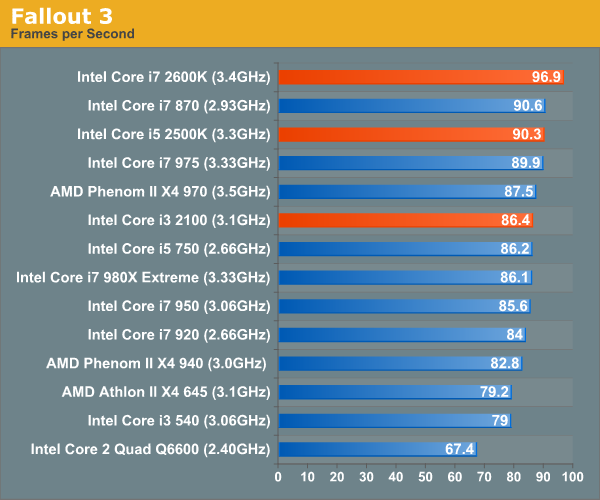
In testing Left 4 Dead we use a custom recorded timedemo. We run on a GeForce GTX 280 at 1680 x 1050 with all quality options set to high. No AA/AF enabled.

Far Cry 2 ships with several built in benchmarks. For this test we use the Playback (Action) demo at 1680 x 1050 in DX9 mode on a GTX 280. The game is set to medium defaults with performance options set to high.
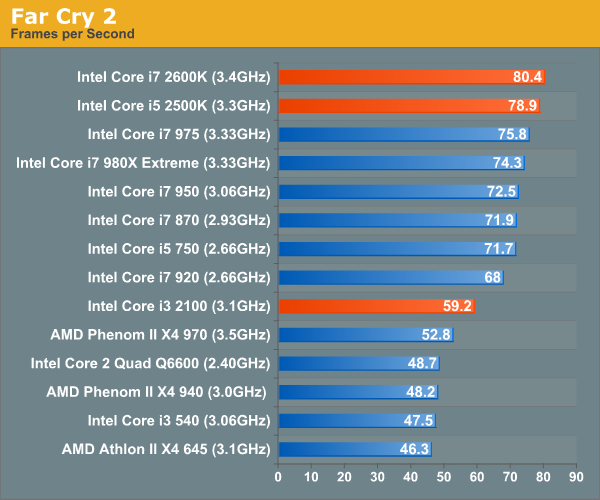
Crysis Warhead also ships with a number of built in benchmarks. Running on a GTX 280 at 1680 x 1050 we run the ambush timedemo with mainstream quality settings. Physics is set to enthusiast however to further stress the CPU.
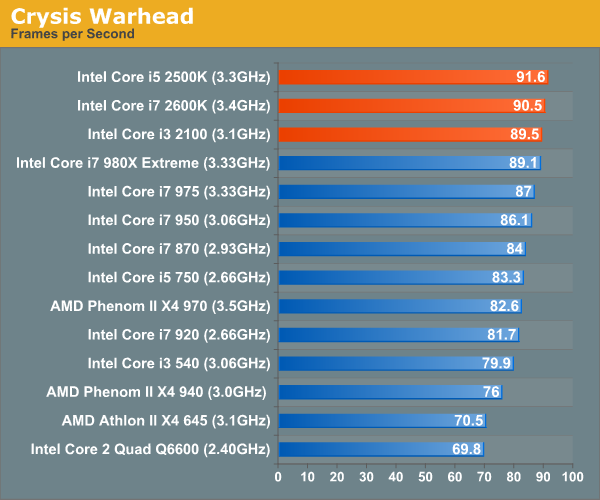
Our Dragon Age: Origins benchmark begins with a shift to the Radeon HD 5870. From this point on these games are run under our Bench refresh testbed under Windows 7 x64. Our benchmark here is the same thing we ran in our integrated graphics tests - a quick FRAPS walkthrough inside a castle. The game is run at 1680 x 1050 at high quality and texture options.
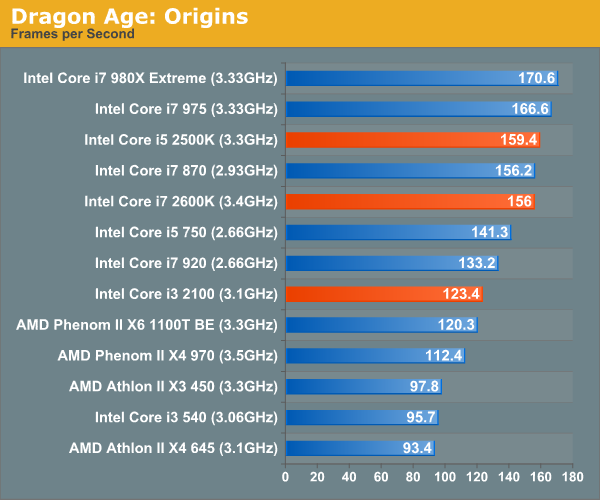
We're running Dawn of War II's internal benchmark at high quality defaults. Our GPU of choice is a Radeon HD 5870 running at 1680 x 1050.
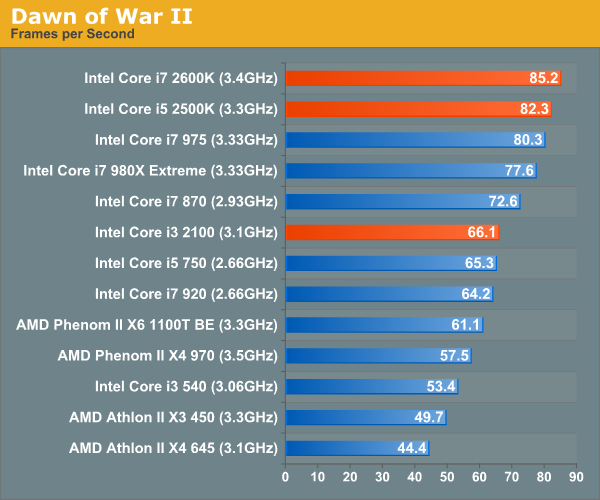
Our World of Warcraft benchmark is a manual FRAPS runthrough of a lightly populated server with no other player controlled characters around. The frame rates here are higher than you'd see in a real world scenario, but the relative comparison between CPUs is accurate.
We run on a Radeon HD 5870 at 1680 x 1050. We're using WoW's high quality defaults but with weather intensity turned down all the way.
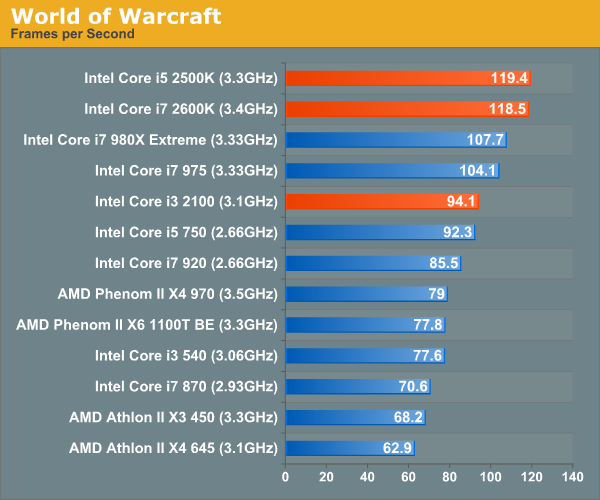
For Starcraft II we're using our heavy CPU test. This is a playback of a 3v3 match where all players gather in the middle of the map for one large, unit-heavy battle. While GPU plays a role here, we're mostly CPU bound. The Radeon HD 5870 is running at 1024 x 768 at medium quality settings to make this an even more pure CPU benchmark.
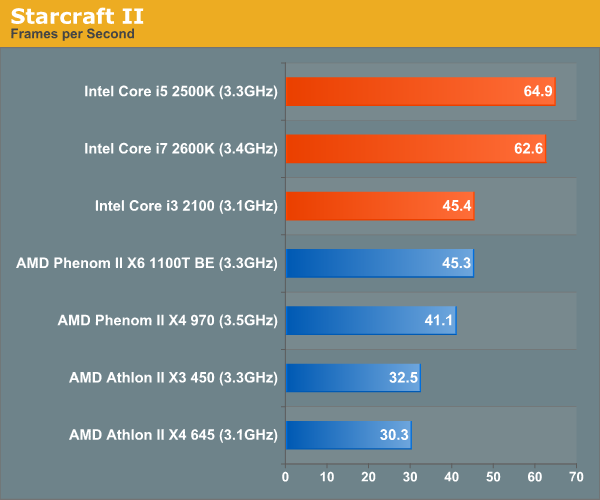
This is Civ V's built in Late GameView benchmark, the newest addition to our gaming test suite. The benchmark outputs three scores: a full render score, a no-shadow render score and a no-render score. We present the first and the last, acting as a GPU and CPU benchmark respectively.
We're running at 1680 x 1050 with all quality settings set to high. For this test we're using a brand new testbed with 8GB of memory and a GeForce GTX 580.
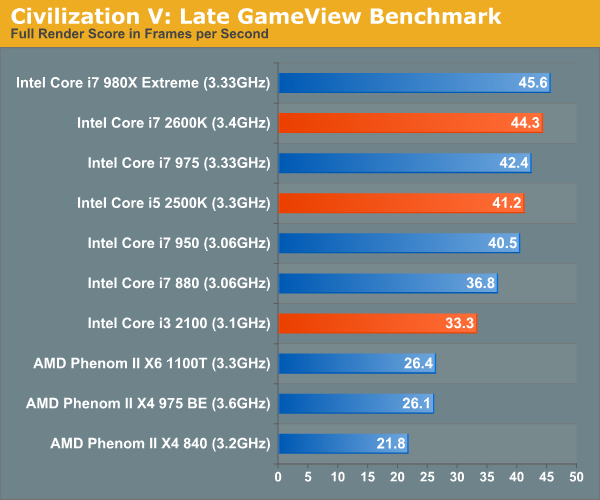
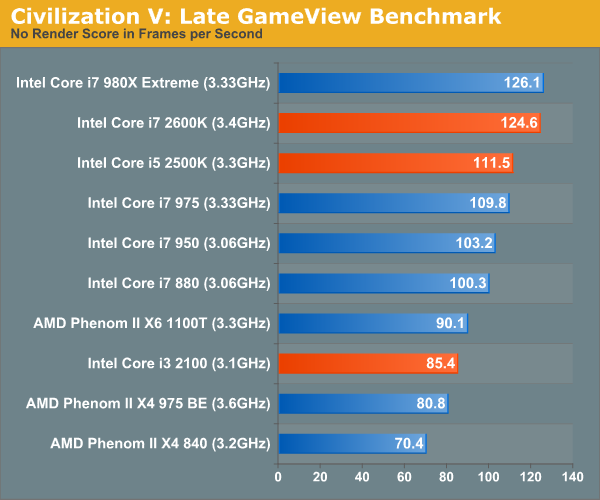










283 Comments
View All Comments
Exodite - Monday, January 3, 2011 - link
I'm of two minds about that really.I had really set my mind on the 2500K as it offers unparalleled bang-for-buck and real-world testing have shown that Hyper-threading makes little difference in games.
With the compile tests it's clear there's a distinct benefit to going with the 2600K for me though, which means this'll end up more expensive than I had planned! :)
Lazlo Panaflex - Monday, January 3, 2011 - link
FYI, the 1100T is missing from several of the gaming benchmarks.....Melted Rabbit - Monday, January 3, 2011 - link
It wouldn't surprise me if that was intentional. I would hope that Anandtech reviewers were not letting companies dictate how their products were to be reviewed lest AT be denied future prerelease hardware. I can't tell from where I sit and there appears to be no denial that stating there is no such interference.In addition, real world benchmarks aside from games looks to be absent. Seriously, I don't use my computer for offline 3D rendering and I suspect that very few other readers do to any significant degree.
Also, isn't SYSMark 2007 a broken, misleading benchmark? It was compiled on Intel's compiler, you know the broken one that degrades performance on AMD and VIA processors unnecessarily. Also there is this bit that Intel has to include with its comparisons that use BAPco(Intel) benchmarks that include Intel's processors with comparisons to AMD or VIA processors:
Software and workloads used in performance tests may have been optimized for performance only on Intel microprocessors. Performance tests, such as SYSmark and MobileMark, are measured using specific computer systems, components, software, operations and functions. Any change to any of those factors may cause the results to vary. You should consult other information and performance tests to assist you in fully evaluating your contemplated purchase, including the performance of that product when combined with other products.
It isn't perfect, but that is what the FTC and Intel agreed to, and until new benchmarks are released by BAPco that do not inflict poor performance on non-Intel processors, the results are not reliable. I don't see any problem if the graph did not contain AMD processors, but that isn't what we have here. If you are curious, for better or for worse, BAPco is a non-profit organization controlled by Intel.
Anand Lal Shimpi - Monday, January 3, 2011 - link
Hardware vendors have no input into how we test, nor do they stipulate that we must test a certain way in order to receive future pre-release hardware. I should also add that should a vendor "cut us off" (it has happened in the past), we have many ways around getting supplied by them directly. In many cases, we'd actually be able to bring you content sooner as we wouldn't be held by NDAs but it just makes things messier overall.Either way, see my response above for why the 1100T is absent from some tests. It's the same reason that the Core i7 950 is absent from some tests, maintaining Bench and adding a bunch of new benchmarks meant that not every test is fully populated with every configuration.
As far as your request for more real world benchmarks, we include a lot of video encoding, file compression/decompression, 3D rendering and even now a compiler test. But I'm always looking for more, if there's a test out there you'd like included let me know! Users kept on asking for compiler benchmarks which is how the VS2008 test got in there, the same applies to other types of tests.
Take care,
Anand
Melted Rabbit - Tuesday, January 4, 2011 - link
Thanks for replying to my comment. I was understand why the review was missing some benchmarks for processors like the 1100T. I was also a bit hasty in my accusations with respect to interference from manufacturers, which I apologize for.I still have trouble with including benchmarks compiled on the Intel compiler without a warning or explanation of what they mean. It really isn't a benchmark with meaningful results if the 1100T is used x87 code and the Core i7-2600K used SSE2/SSE3 code. I would have no problem with reporting results for benchmarks compiled with Intel's defective compiler, like SYSmark 2007 and Cinebench R10 assuming they did not include results for AMD or VIA processors along with an explanation of why they were not applicable to AMD and VIA processors. However, not giving context to such results I find problematic.
DanNeely - Monday, January 3, 2011 - link
Sysmark2k7 is like the various 3dmark benches. Mostly useless but with a large enough fanbase that running it is less hassle than dealing with all the whining fanboi's/Anand Lal Shimpi - Monday, January 3, 2011 - link
There are a few holes in the data we produce for Bench, I hope to fill them after I get back from CES next week :) You'll notice there are some cases where there's some Intel hardware missing from benchmarks as well (e.g. Civ V).Take care,
Anand
Lazlo Panaflex - Monday, January 3, 2011 - link
Thanks Anand :-)MeSh1 - Monday, January 3, 2011 - link
Seems Intel did everything right for these to fit snuggly into next gen macs. Everthing nicely integrated into one chip and the encode/trascode speed boost is icing on the cake (If supported of course) being that Apple is content focused. Nice addition if youre a mac user.Doormat - Monday, January 3, 2011 - link
Except for the whole thing about not knowing if the GPU is going to support OpenCL. I've heard Intel is writing OpenCL drivers for possibly a GPU/CPU hybrid, or utilizing the new AVX instructions for CPU-only OpenCL.Other than that, the AT mobile SNB review included a last-gen Apple MBP 13" and the HD3000 graphics could keep up with the Nvidia 320M - it was equal to or ahead in low-detail settings and equal or slightly behind in medium detail settings. Considering Nvidia isn't going to rev the 320M again, Apple may as well switch over to the HD3000 now and then when Ivy Bridge hits next year, hopefully Intel can deliver a 50% perf gain in hardware alone from going to 18 EUs (and maybe their driver team can kick in some performance there too).